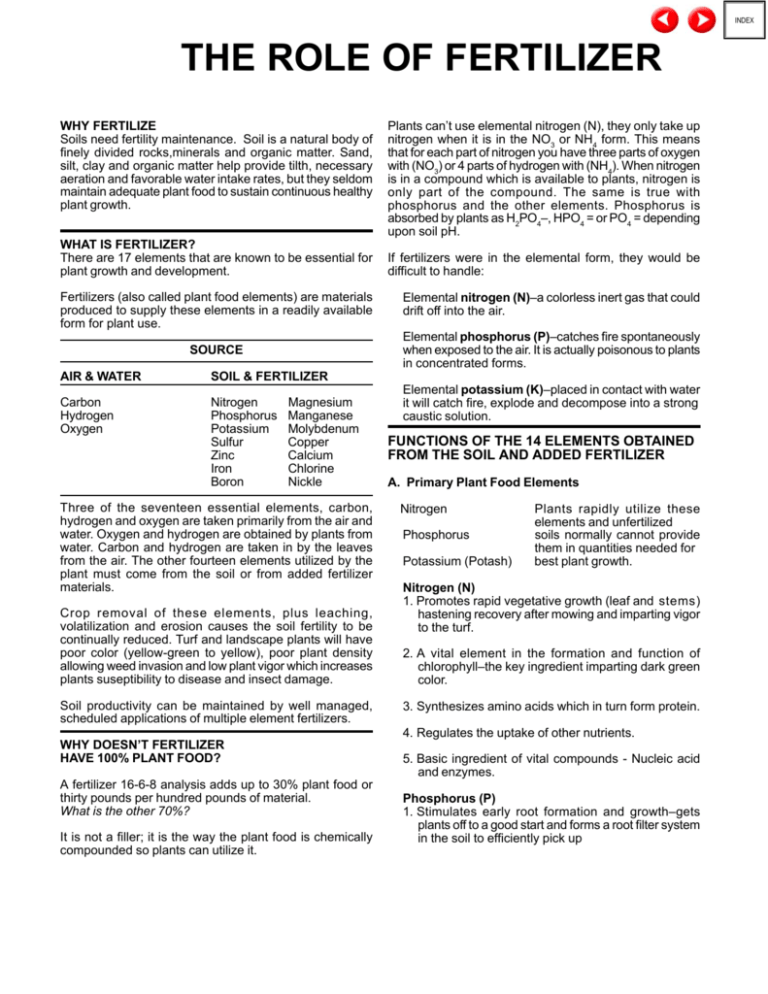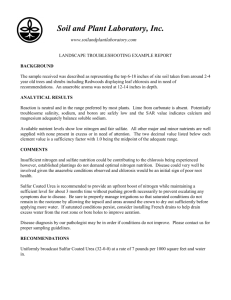THE ROLE OF FERTILIZER
advertisement

INDEX THE ROLE OF FERTILIZER WHY FERTILIZE Soils need fertility maintenance. Soil is a natural body of finely divided rocks,minerals and organic matter. Sand, silt, clay and organic matter help provide tilth, necessary aeration and favorable water intake rates, but they seldom maintain adequate plant food to sustain continuous healthy plant growth. WHAT IS FERTILIZER? There are 17 elements that are known to be essential for plant growth and development. Fertilizers (also called plant food elements) are materials produced to supply these elements in a readily available form for plant use. Plants can’t use elemental nitrogen (N), they only take up nitrogen when it is in the NO3 or NH4 form. This means that for each part of nitrogen you have three parts of oxygen with (NO3) or 4 parts of hydrogen with (NH4). When nitrogen is in a compound which is available to plants, nitrogen is only part of the compound. The same is true with phosphorus and the other elements. Phosphorus is absorbed by plants as H2PO4–, HPO4 = or PO4 = depending upon soil pH. If fertilizers were in the elemental form, they would be difficult to handle: Elemental nitrogen (N)–a colorless inert gas that could drift off into the air. Elemental phosphorus (P)–catches fire spontaneously when exposed to the air. It is actually poisonous to plants in concentrated forms. SOURCE AIR & WATER SOIL & FERTILIZER Carbon Hydrogen Oxygen Nitrogen Phosphorus Potassium Sulfur Zinc Iron Boron Magnesium Manganese Molybdenum Copper Calcium Chlorine Nickle Three of the seventeen essential elements, carbon, hydrogen and oxygen are taken primarily from the air and water. Oxygen and hydrogen are obtained by plants from water. Carbon and hydrogen are taken in by the leaves from the air. The other fourteen elements utilized by the plant must come from the soil or from added fertilizer materials. Crop removal of these elements, plus leaching, volatilization and erosion causes the soil fertility to be continually reduced. Turf and landscape plants will have poor color (yellow-green to yellow), poor plant density allowing weed invasion and low plant vigor which increases plants suseptibility to disease and insect damage. Soil productivity can be maintained by well managed, scheduled applications of multiple element fertilizers. Elemental potassium (K)–placed in contact with water it will catch fire, explode and decompose into a strong caustic solution. FUNCTIONS OF THE 14 ELEMENTS OBTAINED FROM THE SOIL AND ADDED FERTILIZER A. Primary Plant Food Elements Nitrogen Phosphorus Potassium (Potash) Plants rapidly utilize these elements and unfertilized soils normally cannot provide them in quantities needed for best plant growth. Nitrogen (N) 1. Promotes rapid vegetative growth (leaf and stems) hastening recovery after mowing and imparting vigor to the turf. 2. A vital element in the formation and function of chlorophyll–the key ingredient imparting dark green color. 3. Synthesizes amino acids which in turn form protein. 4. Regulates the uptake of other nutrients. WHY DOESN’T FERTILIZER HAVE 100% PLANT FOOD? A fertilizer 16-6-8 analysis adds up to 30% plant food or thirty pounds per hundred pounds of material. What is the other 70%? It is not a filler; it is the way the plant food is chemically compounded so plants can utilize it. 5. Basic ingredient of vital compounds - Nucleic acid and enzymes. Phosphorus (P) 1. Stimulates early root formation and growth–gets plants off to a good start and forms a root filter system in the soil to efficiently pick up INDEX the other available plant nutrients and water. Improves the strength and stamina of the plant. 2. Helps maintain green color in plants. 3. Improves alkaline soils. 2. Hastens maturity (conversion of starch to sugar). 3. Stimulates blooming and seed development. 4. Helps compacted soils–making them loose and allowing better water penetration. 4. Causes energy transformation and conversion processes in which sugars are converted to hormones, protein and energy to grow new leaves and fruit. Sulfur Note–There are commonly two types of sulfur applied to plants and soils: Sulfate Sulfur - (SO4); Elemental Sulfur (S) 5. Forms nucleic acids (DNA and RNA). Sulfate Sulfur (SO4) Sulfate Sulfur (SO4) is the form taken up for plant food. Many plants require as much sulfur as phosphate in their growth processes. 6. Vital for photosynthesis (greening for plants). 7. Essential for cell division. Potassium (K) 1. Aids in the development of stems and leaves. Sulfate Sulfur (SO4) is contained in gypsum (CaSO4) and other sulfate fertilizers–Ammonium Sulfate, Ammonium Phosphate Sulfate and many turf fertilizers. 3. Strengthens cell walls, causing grass to stand up and reduces lodging. Gypsum (CaSO4) will help reclaim alkali soils and make them loose and friable. Alkali soils contain sodium which causes soil to disperse, puddle and seal up. The free calcium from gypsum will replace the sodium on the clay particle and allow the sodium to be leached out of the soil. 4. Affects water intake by plant cells–plants with inadequate potassium may wilt in the presence of ample moisture. It also causes the small soil particles to flocculate (join together in small crumbs), leaving space between them for air and water movement. 2. Increases disease resistance and hardiness which helps wearability. 5. Acts as a catalyst in Iron uptake. 6. Essential to the formation and translocation of protein, starches, sugar and oil–improving the size and quality of fruit, grains and tubers. B. Secondary Plant Food Elements Calcium Magnesium Sulfur They are used in somewhat less quantities than the primary elements, but they are just as essential for plant growth and quality. . Calcium (Ca) 1. Calcium is an essential part of cell wall structure and must be present for the formation of new cells. HOW SULFUR & GYPSUM RECLAIMS SODIUM SOILS ABSORBED SODIUM Too much sodium attached to clay particles tends to make the particles pack together in such a way that water cannot get through. SOLUBLE CALCIUM Sulfur materials furnish soluble calcium, which replaces the excess absorbed sodium. 2. Deficiency of calcium causes weakened stems and premature shedding of blossoms and buds. WATER Magnesium (Mg) 1. Essential for photosynthesis (greening of plant). 2. Activator for many plant enzymes required in growth process. Sulfur (S) 1. A constituent of three amino acids and is therefore essential in the formation of protein. This replacement allows the soil particles to group themselves so that larger pore spaces are formed. EXCESS SALTS Then when the soil is flooded, the water can pass through and wash out excess salts, including sodium. INDEX Elemental Sulfur (S) Elemental Sulfur (S) will convert to sulfate sulfur in the soil. This reaction can be slow, depending upon the sulfur particle size and the soil conditions. Once it has converted to sulfate sulfur (SO4), it is available to the plant. If the soil contains calcium, it can form gypsum in the soil and be used for reclamation of alkaline soils. Elemental sulfur will lower the pH of the soil at the location of the pellet as it converts to sulfate. (See the article on Turf and Sulfur). chlorophyll in the plant cell (causes turf to maintain a healthy green color). It serves as a catalyst for biological processes such as respiration, symbiotic fixation of nitrogen and photosynthesis. Applications of iron can correct iron deficiency, but it may be temporary in high pH soils, due to tie up with calcium. This may require acidification of the soil with elemental sulfur or the use of ammonium forms of nitrogen or some other acidification agents. As ammonium converts to nitrate in the soil, it has an acidifying effect. This acidifying effect makes iron and many other elements more available in high pH soils. C. Micronutrients: Iron, Zinc and Manganese Zinc (Zn) Even though micronutrients are used by plants in very small amounts, they are just as essential for plant growth as large amounts of primary and secondary nutrients. They must be maintained in balance in order for all nutrients and water to be used efficiently. Zinc is an essential component of several plant enzymes. It is a part of auxins and controls the synthesis of indoleacetic acid which regulates growth compounds. Zinc also affects the intake and efficient use of water by plants. On turf grass there are three micronutrients that are particularly important in order to maintain green color and plant vigor: Manganese (Mn) Iron (Fe) Yellowing of grass (Iron Chlorosis) is often due to iron deficiency. Iron is required for the formation of Manganese serves as an activator for enzymes in plants. Without Manganese, the plants cannot use the iron which they have absorbed. It assists the iron in chlorophyll formation which causes yellowish turf to green up.





